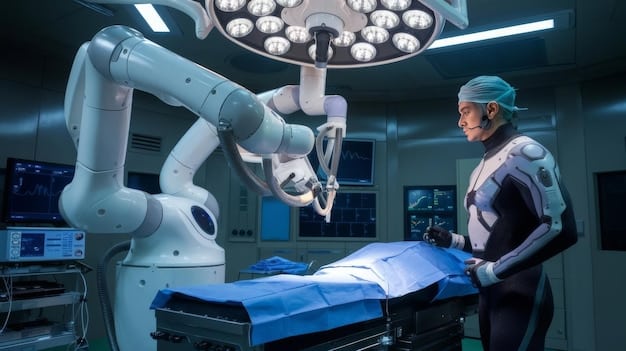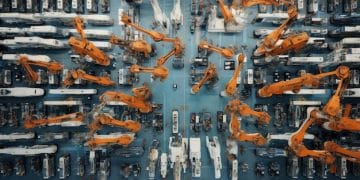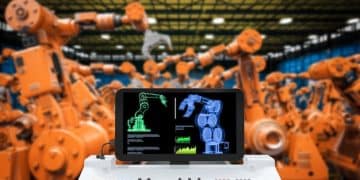US Robotics Regulations & Your 2025 Automation Plans: What to Expect

Navigating potential new US robotics regulations in 2025 is crucial for businesses as these policies could significantly reshape automation strategies, impacting everything from design and deployment to operational costs and ethical compliance across various industries.
As 2025 approaches, many businesses are asking: Will new US robotics regulations impact your 2025 automation plans? The answer is complex, reflecting a rapidly evolving landscape where technological innovation often outpaces legislative frameworks. Understanding these potential shifts is vital for strategic planning.
the evolving landscape of robotics regulation in the US
The United States has historically adopted a reactive, rather than proactive, approach to regulating emerging technologies. While this strategy fosters rapid innovation, it can also lead to regulatory gaps. With robotics becoming increasingly sophisticated and ubiquitous, particularly in manufacturing, logistics, healthcare, and even defense, calls for more defined guidelines are growing louder. Businesses must understand this dynamic to anticipate future changes.
The current regulatory environment for robotics in the US is a patchwork of existing laws, often adapted from other sectors, rather than a cohesive, robot-specific framework. This includes workplace safety standards from OSHA, data privacy laws like HIPAA (for medical robots) or CCPA (for consumer robots), and even product liability laws that apply to any manufactured good. However, these existing laws don’t fully address the unique challenges posed by autonomous systems, such as ethical considerations, job displacement, or cybersecurity vulnerabilities inherent in interconnected robotic networks.
current government initiatives and discussions
Several government bodies and think tanks are actively engaged in discussing and researching potential robotics regulations. These discussions often focus on broad principles rather than specific rules, due to the rapid pace of technological change. The goal is to create frameworks that are flexible enough to adapt but robust enough to ensure safety and ethical conduct.
- National Artificial Intelligence Initiative Office (NAIIO): While primarily focused on AI, its work inevitably touches upon autonomous robotic systems, especially regarding ethical AI development and data governance.
- National Institute of Standards and Technology (NIST): NIST develops standards and guidelines to improve cybersecurity and interoperability for various technologies, including robotics. Their voluntary frameworks often serve as precursors to mandatory regulations.
- Congressional Hearings: Various committees have held hearings on the impact of AI and automation on the workforce, national security, and privacy, signaling legislative interest in these areas.
These initiatives indicate a growing awareness at the federal level that specific robotics regulations may be necessary. For businesses, this means staying abreast of these conversations, as they are the earliest indicators of future policy. Ignoring these signals could lead to significant compliance challenges down the line.
While definitive laws are still nascent, the direction of these discussions heavily influences industry best practices, which can then become de facto standards, and eventually, formal regulations. Companies investing in automation should consider these evolving dialogues as integral to their 2025 planning.
key areas of potential regulatory focus for 2025
As the debate around robotics intensifies, several critical areas are emerging as likely targets for new or reinforced regulations by 2025. These areas reflect both public concerns and the practical challenges of integrating advanced automation into society and industry. Businesses need to understand these potential focal points to proactively adapt their automation strategies.
safety and liability in autonomous systems
The safety of robots operating in shared spaces with humans, whether in factories, homes, or public areas, is paramount. Current liability laws are often ill-equipped to handle accidents involving autonomous systems where culpability can be complex. Is it the manufacturer, the programmer, the operator, or the end-user? New regulations could aim to clarify these questions.
- Design for Safety: Requirements for fail-safes, emergency stops, and robust sensor systems to prevent accidents.
- Certification and Testing: Mandates for rigorous testing and independent certification of autonomous features before deployment.
- Liability Allocation: Clearer legal frameworks defining responsibility in case of malfunction, injury, or damage caused by a robot.
The financial implications of liability are significant. Increased clarity could lead to higher insurance premiums for robotic deployments or require companies to invest more in verifiable safety mechanisms. For 2025 plans, prioritizing verifiable safety records and robust design will be key.
data privacy and cybersecurity implications
Robots, especially those interacting with the environment and people, often collect vast amounts of data—from visual and auditory information to operational metrics and personal identifiers. This raises significant privacy concerns and presents new cybersecurity risks. Future regulations are likely to address these vulnerabilities.
Companies must prepare for stricter guidelines on how data collected by robots is stored, processed, and used. This could involve mandates for data anonymization, explicit consent mechanisms, and enhanced encryption protocols to protect sensitive information. Non-compliance could result in hefty fines and reputational damage. Furthermore, the interconnected nature of modern robotic systems makes them potential targets for cyberattacks, which could lead to operational disruption, data breaches, or even physical harm. Regulations might impose higher cybersecurity standards, requiring more resilient systems and regular security audits.

ethical considerations and societal impact
The ethical dimensions of robotics, from job displacement to algorithmic bias and decision-making by autonomous weapons systems, are increasingly drawing government attention. While direct legislation on ethics can be challenging, policies could emerge that encourage or mandate ethical design principles.
This might include requirements for transparency in robotic decision-making processes, particularly in applications affecting human lives or livelihoods. Discussions around “robot rights” or the legal status of autonomous entities are also nascent but illustrate the depth of ethical inquiry. Businesses integrating advanced AI-powered robots may need to demonstrate their commitment to ethical use and social responsibility. This could indirectly influence automation plans, pushing companies towards solutions that augment human capabilities rather than simply replacing them, or requiring social impact assessments for large-scale automation projects.
These potential regulatory areas underscore a shift towards more holistic governance of robotics. For businesses, the message is clear: proactive engagement with these issues, rather than waiting for mandates, will be a competitive advantage in 2025 and beyond.
impact on specific industries and sectors
The potential new US robotics regulations will not affect all industries equally. The nature of robotic deployment, the level of human-robot interaction, and the sensitivity of data handled vary significantly across sectors. Recognizing these differences is crucial for any business formulating its 2025 automation plans. Different industries will face unique challenges and opportunities under an evolving regulatory framework.
manufacturing and logistics
These sectors are pioneers in robotics adoption, utilizing everything from collaborative robots (cobots) to autonomous mobile robots (AMRs) for tasks like assembly, material handling, and inventory management. Regulations here will likely focus on workplace safety, interoperability standards, and human-robot collaboration.
- Enhanced Safety Protocols: Stricter guidelines for cobot operation, including speed limits, force limits, and mandatory safety zones, potentially increasing initial setup costs but reducing long-term accident liabilities.
- Certification for AMRs: Autonomous Forklifts and AMRs may require specific certifications for navigating shared warehouse spaces with human workers, impacting deployment timelines.
- Data Exchange Standards: Regulations promoting open standards for data exchange between different robotic systems and existing IT infrastructure to improve efficiency while ensuring data security.
Businesses in manufacturing and logistics should anticipate higher compliance costs but also potential benefits from clearer safety guidelines and improved interoperability. They might also see a push towards human-robot teaming solutions that emphasize augmentation rather than pure replacement, influenced by ethical considerations.
healthcare and medical robotics
Robots in healthcare, from surgical assistants to diagnostic aids and patient support systems, have a direct impact on human health and well-being. Regulations in this sector are expected to be particularly stringent, focusing on patient safety, data privacy (HIPAA compliance), and ethical use.
New regulations could mandate more rigorous clinical trials and FDA approvals for robotic medical devices, similar to pharmaceuticals, extending development cycles. The privacy of patient data collected by diagnostic or assistive robots will be a major concern, potentially requiring enhanced encryption and consent frameworks. Moreover, liability in cases of robotic malfunction during surgery or patient care will be critical, pushing manufacturers and healthcare providers to implement robust redundant systems and clear operational protocols. The ethical implications of AI-powered diagnostic tools, including potential biases, are also likely to come under scrutiny.

autonomous vehicles and transportation
While often discussed separately from industrial robotics, autonomous vehicles (AVs) represent a significant subset of robotics. Regulations for AVs are currently fragmented at state and federal levels and are a prime candidate for more unified and comprehensive oversight by 2025. This would affect trucking, delivery drones, and self-driving taxis.
Focus areas will include standardized testing procedures, clear definitions of operational design domains (ODDs), and mandated data recording for accident investigation. Liability frameworks for AV accidents are also a major point of contention and will likely see legislative efforts to clarify responsibility between vehicle manufacturers, software developers, and fleet operators. Cybersecurity for AVs, to prevent hacking and ensure safe operation, will also be a high priority. Businesses planning to integrate AVs into their logistics or service models must closely monitor these developments, as they will directly impact deployment feasibility and insurance costs.
Each sector must evaluate how potential regulations could specifically alter their cost structures, operational workflows, and competitive landscapes. Proactive planning, including internal audits of current automation practices against anticipated regulatory trends, will be vital for a smooth transition into 2025’s robotic future.
adapting your 2025 automation plans: a strategic guide
The prospect of new US robotics regulations by 2025 shouldn’t be viewed as a roadblock, but rather as an opportunity for strategic refinement. forward-thinking businesses will use this period to strengthen their automation frameworks, ensuring compliance while maintaining innovation. This calls for a multi-faceted approach that integrates regulatory anticipation into core business and technology planning.
proactive compliance and risk mitigation
Waiting for regulations to be enacted before reacting can lead to costly retrofits and operational delays. A proactive stance involves monitoring legislative trends, engaging with industry bodies, and initiating internal compliance audits. This helps identify potential gaps early.
- Regulatory Watch: Dedicate resources to track proposed legislation, white papers from government agencies, and industry standards related to robotics.
- Internal Audits: Conduct regular assessments of existing and planned robotic systems against anticipated regulatory requirements, focusing on safety, data privacy, and ethical guidelines.
- Scenario Planning: Develop contingency plans for different regulatory outcomes, including stricter rules on liability, data handling, or operational permits.
Mitigating risk also involves investing in robust technical solutions. This includes designing automation systems with modularity to facilitate future updates and compliance changes, and incorporating advanced cybersecurity measures from the outset. Furthermore, clear documentation of design choices, testing procedures, and operational protocols will be invaluable in demonstrating compliance.
investing in human-robot collaboration and training
Regulations, particularly those driven by ethical concerns and job displacement, might favor automation solutions that enhance human capabilities. This means shifting focus from pure replacement to systems that enable human-robot collaboration (HRC).
Investing in HRC technologies, such as cobots designed to work alongside humans, can align with potential regulations emphasizing worker safety and skill augmentation. Furthermore, adequate training programs for employees on how to operate, maintain, and safely interact with robots will be critical. This not only improves operational efficiency but also addresses potential regulatory demands for competent human oversight and emergency response. Such investments can also improve employee morale and foster a more positive public image, easing regulatory scrutiny.
engaging with policymakers and industry groups
Businesses have a vested interest in shaping future robotics regulations. Active engagement with government bodies and industry associations provides an opportunity to offer practical insights, influence policy direction, and stay informed about upcoming changes. Industry consortiums often lead in developing best practices that can later be adopted into formal regulations.
Participating in pilot programs, providing feedback on draft proposals, and lobbying for balanced regulations can ensure that new rules are practical, technologically feasible, and do not stifle innovation unnecessarily. This collaborative approach can help create a regulatory environment that supports the responsible growth of the robotics industry, benefiting both businesses and society.
Ultimately, successful automation strategies for 2025 will be those that integrate regulatory foresight into every stage of planning and deployment. This proactive and collaborative approach will ensure longevity and resilience in an increasingly regulated robotic ecosystem.
the role of international standards and global trends
While the focus is on US regulations, it’s crucial for businesses to understand that robotics operates within a global context. International standards and global regulatory trends often influence domestic policy. The US, though a leader in innovation, rarely acts in a vacuum when it comes to regulating transformative technologies. Observing these broader patterns can provide valuable early indicators for what might become prevalent in US law.
harmonization efforts and their implications
There’s a growing push for harmonization of robotics standards and regulations across different countries and economic blocs. Organizations like the International Organization for Standardization (ISO) and the International Electrotechnical Commission (IEC) are actively developing global standards for robot safety, performance, and interoperability. Although these are typically voluntary, they frequently form the basis for national regulations.
For example, ISO 10218 (Safety requirements for industrial robots) and ISO/TS 15066 (Technical specification for collaborative robots) and IEC 61508 (Functional safety of electrical/electronic/programmable electronic safety-related systems) already influence US industry practices and safety guidelines, even without direct federal mandate. If a US company aims for global markets, adhering to international standards becomes imperative, regardless of specific US regulatory timelines. This often means that even if a US regulation hasn’t been codified, operating to international best practices can provide a competitive edge and ease future compliance.
lessons from the European union and other regions
The European Union (EU) is often at the forefront of digital and technological regulation, with frameworks like the General Data Protection Regulation (GDPR) setting global benchmarks for data privacy. The EU is also actively developing specific AI and robotics regulations, including proposed AI Acts that could dictate how autonomous systems are developed, deployed, and used.
The EU’s comprehensive approach, which often includes ethical guidelines, risk assessments, and robust liability frameworks, can serve as a bellwether for potential US actions. While the US legal system differs significantly, the principles behind EU regulations—such as transparency, accountability, and human oversight—are likely to resonate with US policymakers. Similarly, countries like Japan and South Korea, with their strong robotics industries, are also developing nuanced regulatory approaches that the US may observe. Businesses should study these international precedents to anticipate the scope and depth of future US regulations, particularly concerning ethical AI, data governance, and product liability for advanced robotic systems.
Ignoring these global trends would be shortsighted. A holistic automation strategy for 2025 and beyond must consider not only domestic regulatory shifts but also the broader international currents that will inevitably shape the robotics landscape. Aligning with global best practices positions a company for success on multiple fronts.
forecasting the future: scenarios for 2025 and beyond
Peering into the crystal ball for robotics regulations in 2025 reveals a spectrum of possibilities. No one can predict the future with absolute certainty, but by analyzing current trends, political will, and technological momentum, we can outline plausible scenarios. These scenarios serve as frameworks for businesses to develop adaptive strategies, regardless of the precise regulatory path.
scenario 1: incremental regulatory adjustments
This scenario suggests that by 2025, the US government will implement minor adjustments to existing laws, rather than enacting entirely new, sweeping robotics legislation. These changes would likely refine current product liability laws, update OSHA guidelines for human-robot interaction, and extend existing data privacy regulations to better cover robotic data collection. The focus would be on addressing immediate and pressing issues with minimal disruption to innovation. This approach is often favored in economic climates prioritizing tech growth.
For businesses, this means a gradual need to update internal policies and ensure compliance with slightly modified standards. The cost impact would be moderate, primarily related to updating documentation, recalibrating safety protocols, and making minor design adjustments. Automation plans for 2025 would proceed largely as intended, with an emphasis on continuous improvement in safety and data handling based on evolving best practices.
scenario 2: targeted legislation for high-risk areas
In this scenario, 2025 could see the introduction of specific federal legislation targeting particular high-risk applications of robotics. This might include dedicated laws for autonomous vehicles, medical robotics, or defense applications, where the potential for harm or ethical dilemmas is most pronounced. These targeted regulations would likely impose more stringent certification requirements, clear liability frameworks, and mandates for ethical AI design within those specific domains.
Businesses operating in these high-risk sectors would face significant compliance challenges, requiring substantial investment in research, development, and testing to meet new regulatory hurdles. Automation plans would need to be re-evaluated to account for potentially longer development cycles and higher compliance costs. Companies outside these high-risk areas might see less direct impact but would still be influenced by the precedent set by these targeted laws, potentially leading to increased scrutiny of their own applications.
scenario 3: comprehensive federal framework
The most impactful scenario involves the creation of a comprehensive federal framework for robotics and AI by 2025, similar to the EU’s proposed AI Act. This would encompass broad principles for ethical AI, data governance across all robotic applications, worker displacement policies, and possibly even a federal agency or oversight body dedicated to robotics. This scenario would reflect a strong political consensus on the need for proactive governance of advanced technologies.
Under a comprehensive framework, all businesses deploying robotics would experience a significant shift. There would be a foundational set of rules dictating everything from design and manufacturing to deployment, operation, and decommissioning. While this would create a more predictable regulatory environment in the long run, the initial transition would be complex and costly. Automation plans would require a complete overhaul, with compliance becoming a central pillar of strategy. However, it could also foster greater public trust and accelerate a more responsible integration of robotics into society.
Regardless of the scenario that unfolds, preparedness is key. Businesses should consider the implications of each possibility and build flexibility into their 2025 automation plans to navigate the changing regulatory tides effectively. The future of robotics in the US will undoubtedly be shaped by these evolving policy discussions.
key takeaways for your 2025 automation strategy
As we’ve explored, the question “Will new US robotics regulations impact your 2025 automation plans?” isn’t a simple yes or no, but rather an invitation to strategic foresight and adaptability. The regulatory landscape, while still evolving, shows clear signs of increasing scrutiny and formalization. Businesses that proactively engage with these trends will be better positioned for success and sustainable growth in the era of advanced automation.
The core message is to integrate regulatory awareness into every stage of your planning. From initial design to full-scale deployment, consider the implications of potential shifts in safety standards, data privacy laws, ethical guidelines, and liability frameworks. This proactive stance isn’t just about avoiding penalties; it’s about building resilient, trustworthy, and socially responsible automation solutions that will command greater public and governmental confidence.
Furthermore, remember that the conversation around robotics is dynamic. Stay informed through industry groups, engage with policy discussions, and view international regulatory developments as potential indicators for future US trends. Your 2025 automation strategy should not be static, but rather a living document that adapts to the ongoing dialogue between technological innovation and societal governance.
By prioritizing ethical AI, robust safety features, transparent data handling, and meaningful human-robot collaboration, your organization can not only comply with future regulations but also lead the way in shaping a beneficial and sustainable robotic future. The impact of new regulations will be less about restriction and more about refinement for those prepared to embrace responsible automation.
| Key Aspect | Brief Impact Description |
|---|---|
| 🏗️ Safety & Liability | New rules may demand stricter design, testing, and clearer responsibility for autonomous systems, increasing compliance costs. |
| 🔒 Data Privacy & Security | Expect tighter controls on data collection, storage, and cybersecurity for robotic platforms to protect sensitive information. |
| 🤝 Ethical AI & Workforce | Regulations could favor solutions that augment human work and require transparency in AI decision-making, impacting HR and R&D. |
| 🌐 Global Standards | International norms from the EU or ISO often influence US policy, requiring global awareness for competitive advantage. |
Frequently asked questions about robotics regulations
Currently, the US does not have comprehensive federal laws specifically for robotics. Instead, robots are subject to a patchwork of existing regulations from various agencies, such as OSHA for workplace safety, FDA for medical devices, and state laws for autonomous vehicles. These frameworks are being adapted, but direct, centralized robotics legislation is still in development or discussion stages.
New regulations could disproportionately affect small businesses by increasing compliance costs, requiring investments in new safety features, or mandating training programs. However, clearer guidelines can also reduce legal risks and build consumer trust. Government support programs or simplified frameworks for small businesses might accompany new regulations to ease the transition and promote broader adoption.
It’s highly probable that regulations will emphasize human oversight, especially for high-risk autonomous systems or those interacting with the public. While robots may become more autonomous, humans will likely remain essential for monitoring, intervention, maintenance, and ethical decision-making. Future policies may even mandate specific qualification and training levels for personnel supervising robotic operations.
Critical data privacy concerns include the collection of personal identifiable information (PII) through sensors, biometric data, and data sharing between devices. Regulations may mandate stricter consent mechanisms, clearer data anonymization requirements, and enhanced cybersecurity measures to prevent breaches. The ethical use of collected data for purposes beyond their primary function will also be a key area of regulatory focus.
Businesses can prepare by staying informed through industry associations, legal advisors, and government publications. They should also prioritize adaptable system designs, robust cybersecurity, comprehensive safety protocols, and ethical AI development. Engaging in proactive internal audits and building flexibility into automation plans will allow companies to adjust quickly to new requirements without significant disruption or costly overhauls.
conclusion: navigating the landscape of automated progress
The journey towards greater automation is undeniable, and with it comes a growing responsibility to ensure that robotic systems are deployed safely, ethically, and equitably. As we look towards 2025, the conversation around US robotics regulations is maturing, moving from nascent discussions to more concrete proposals. Embracing this evolution, rather than resisting it, is crucial for companies aiming to thrive in an increasingly automated world. Proactive engagement with potential regulations isn’t just about compliance; it’s about embedding trust and sustainability into the very fabric of robotic innovation, ensuring a future where technology serves humanity in the most responsible and effective ways possible. The upcoming years will define how the US balances innovation with necessary oversight, setting the stage for decades of robotic integration.





